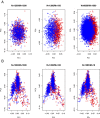Implications of simplified linkage equilibrium SNP simulation
- PMID: 26417113
- PMCID: PMC4603486
- DOI: 10.1073/pnas.1502868112
Implications of simplified linkage equilibrium SNP simulation
Conflict of interest statement
The author declares no conflict of interest.
Figures


Comment in
-
Reply to Lee: Downward bias in heritability estimation is not due to simplified linkage equilibrium SNP simulation.Proc Natl Acad Sci U S A. 2015 Oct 6;112(40):E5452-3. doi: 10.1073/pnas.1511370112. Epub 2015 Sep 28. Proc Natl Acad Sci U S A. 2015. PMID: 26417112 Free PMC article. No abstract available.
Comment on
-
Measuring missing heritability: inferring the contribution of common variants.Proc Natl Acad Sci U S A. 2014 Dec 9;111(49):E5272-81. doi: 10.1073/pnas.1419064111. Epub 2014 Nov 24. Proc Natl Acad Sci U S A. 2014. PMID: 25422463 Free PMC article.
References
-
- Gusev A, et al. Schizophrenia Working Group of the Psychiatric Genomics Consortium SWE-SCZ Consortium Schizophrenia Working Group of the Psychiatric Genomics Consortium SWE-SCZ Consortium Partitioning heritability of regulatory and cell-type-specific variants across 11 common diseases. Am J Hum Genet. 2014;95(5):535–552. - PMC - PubMed
Publication types
MeSH terms
LinkOut - more resources
Full Text Sources
Other Literature Sources
Medical

